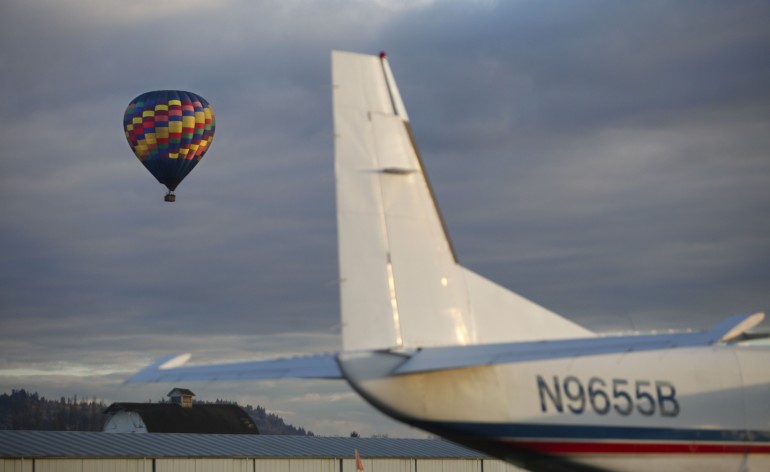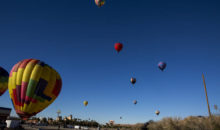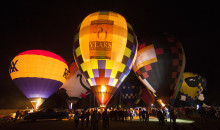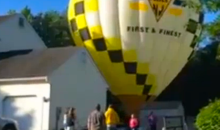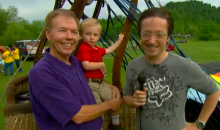Spirit of aviation’s early days lives on at Harvey Field
Floods, fires and family crises — Harvey Field has survived them all.
In 1990, then-10-year-old Preston Harvey stood on the second floor of Snohomish Flying Service and watched the water rise just a few hundred feet away. The Snohomish River had already spilled over its banks, and the waters now threatened the last barrier to the airport, the railroad tracks.
In the next instant, the water breached the tracks, and an explosion of mud and debris raced toward the airport. Preston, his parents Dick and Kandace, and his older brother Lance continued moving valuables to upstairs rooms until the water rose to about two feet. The four of them then walked down the outside stairs into a jet boat that Dick had tied to the railing earlier in the day. Then, Preston says, “We got in and motored home.”
Home was just at the other end of the half-mile runway, and the flood was just one of many that has occurred during Harvey Field’s 70-year history.
Today the privately owned airport employs 119 people at Snohomish Flying Service, several smaller businesses and a restaurant, the Buzz Inn, a small local chain. The airport hasn’t flooded since 1995, after dikes were built. Preston Harvey is now vice president of maintenance.
Although thoroughly modern, with computerized tests, simulators and automated accounting, Harvey Field evokes the early days of aviation, and it’s not hard to imagine Charles Lindbergh in the Spirit of St. Louis floating across the power lines at the end of the runway, touching down on the grass, and joining fellow pilots for a cup of coffee in the Buzz Inn.
The Harveys say that if they have anything to do with it, the little airport will still be that way in another 70 years.
Before pavement
Dick Harvey’s father and grandfather, Eldon and Noble, and family friend Wesley Loback established the airport in 1944. But Harvey Field’s first flight actually took place on May 7, 1911, when famed barnstormer Fred J. Wiseman brought his biplane to Snohomish for an exhibition. The flight wasn’t much — Wiseman took off from a ball field on the Harvey property and landed just a few hundred yards away in the field that later became the airport.
By 1947, the budding grass airfield had hangars, a flight school and buildings for maintenance and administration. In 1950, Eldon incorporated the Snohomish Flying Service, and a year later he bought an Aeronca Champ, a training airplane that still resides at Harvey after more than 13,000 hours in the air. Three generations of Harveys have learned to fly in the Champ.
Dick and Kandace married in 1967, and after Dick’s three-year Army stint, the couple returned to work at and then manage the airport. They added a paved runway, obtained Federal Aviation Administration approval for veterans to use the GI Bill for training at the flight school and extended the hours of the small Skyroom Cafe, which evolved into the Buzz Inn. Soon pilots and aviation enthusiasts from all around Puget Sound flocked to the tiny airport.
For the next two decades, the airport continued to grow. Kandace handled the books and the business side, while Dick raced around the ramp and airfield, repairing and refueling airplanes. After a lengthy battle with cancer, Dick died in 1995, leaving Kandace and their four children to run the airport.
On Jan. 31, 2000, Kandace, now CEO of Harvey Airfield, sat in her office at the north end of the field and watched an airplane bounce down the runway and stagger into the air. The airplane disappeared from her view and she thought, “This doesn’t look right.” Then she saw black smoke.
The airplane had hit the master bedroom in her house, destroying everything except the box springs in her bed. Both pilots survived, but the house had to be completely rebuilt.
In 2014, Kandace is philosophical about the hazards of living at an airport, saying, “It was just a fluke that won’t happen again.”
Skydivers and balloons
One Saturday in January, I pull into Harvey Field’s parking lot around one o’clock. The sun has finally burned through the fog to reveal blue skies, and an airplane climbs out with a load of skydivers. Skydiving began at the airport in 1961 with the Seattle Skydivers, the oldest skydiving club in the U.S., and the current operation, Skydive Snohomish, is owned by Preston’s brother, Tyson.
I grab a latte from Harvey Field Espresso, owned by Preston’s sister, Heather, and then stroll to the Snohomish Flying Service upper deck lounge to watch the action.
Pilots and students zip around with flight instructors clad in bright red polo shirts. Everyone is trying to take advantage of the three hours of remaining daylight. The radio chatters in the background: “Four-one-seven-nine-papa, west of the field, we’ve got the traffic in sight.”
A pilot renting an airplane fills out a form, while a student from Taiwan clutches a kneeboard and flight plan as he walks out to pre-flight an airplane. Since 2010, the Snohomish Flying Service has been teaching about a dozen Taiwanese students each year how to fly. Most go on to fly for Taiwan’s major airline, EVA Air.
The second floor at Harvey is a perfect viewing spot — picture windows, overstuffed chairs and a padded bench, along with free coffee. Mount Rainier pokes above rows of hangars with white and red roofs.
As a tiny Cessna 152 trainer takes off, a red, white and blue parachute appears with a tandem skydiving team — an instructor and student. The instructor nails the bull’s-eye of the skydiving circle. Two minutes later, another team lands on the bull’s-eye. The instructors make it look easy, but the next two jumpers, both solo, miss the target by at least 10 feet.
A bright yellow airplane that sits on its tail, a “tail-dragger,” taxis up to the fuel pump. A worker uses a tug to pull a helicopter out of the maintenance hangar. Little airplanes, mostly tail-draggers, scoot toward the runway as the skydiving plane lands. It looks like controlled chaos on the taxiway. A pilot pulls a twin-engine airplane onto the ramp, the low thrum of its powerful engines bouncing off the hangars, and deftly swings the tail around and shuts it down.
Back downstairs, chief pilot Rich Ren, who has worked as a flight instructor in Africa and was once a pilot for John Travolta, reviews a thick folder of pilot paperwork that looks like an old-fashioned medical record. He briefs the student on what they will be doing on this flight, which is practice for an upcoming pilot-certification flight — flying to nearby Paine Field in Everett, landing, taking off again, maneuvering over Lake Stevens and then returning to Harvey.
It’s now about three o’clock, and a magnificent balloon from the Airial Balloon Co. rises above the field and starts drifting slowly southward. It’s one of the few businesses not owned by a Harvey.
By four o’clock, the sun is dipping low on the horizon, and the sky turns a deep Seattle blue with white streaks of high cirrus. Radio chatter picks up as everyone heads back to land, and the last load of skydivers takes off. As night falls, the aircraft begin to sport red, green and white lights. Airplanes move to tie-down spots, and the tug scoops up a few and takes them to a hangar. The runway lights come on, and I watch the spectacular red sunset.
Freelance aviation writer Eileen Bjorkman has a doctorate in engineering and is a retired Air Force colonel who lives in Everett, WA. She has an airplane hangared at Harvey Field.
via – HeraldNet.com

